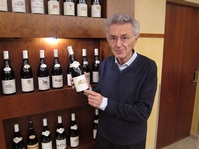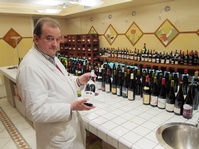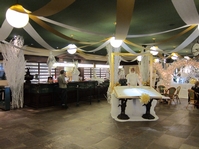Georges DuBoeuf tastes 200 wines a day, almost every day. I stand in awe of this and asked how he does it.
But first, let me put that number in perspective.
Robert Parker, arguably the most prolific professional wine critic, tastes about 100 wines per day. DuBoeuf does that literally before lunch.
The Wine Spectator’s official tasting system is for its critics to sit down with 24 wines at a time, to keep their palates fresh for crucial decisions.
DuBoeuf, who has his own money riding on his decisions, says he needs to taste 10 wines just to warm up.
Homonym alert: DuBoeuf tastes when he has a cold, but won’t taste a wine that’s cold, and doesn’t like to taste anything when the weather is cold.
Why does DuBoeuf need to taste this much? His name is on more wines than probably anybody else in the world.
You might associate DuBoeuf with Beaujolais Nouveau and outrageous promotions of large-production wines. But he tastes hundreds of wines a day because he sells hundreds of different wines every year — including more than 60 exported to the US — and every year he must start anew.
Guy Marion, DuBoeuf’s enologist and right-hand man for 45 years, says that only about 10% of the grapes for DuBoeuf’s 2.5 million annual cases are contracted before the year begins. Everything else goes through the selection process.
Here’s how that works. DuBoeuf and Marion always taste together. If Marion is unavailable for some reason, DuBoeuf drafts somebody else; he  never tastes alone. There’s a contest every year in France for the top sommelier, and DuBoeuf usually invites the winner to come and make a special blend with him; usually the winner accepts. Considering DuBoeuf’s buying power — he gets to say yea or nay to most of the best juice in Beaujolais — wouldn’t you?
never tastes alone. There’s a contest every year in France for the top sommelier, and DuBoeuf usually invites the winner to come and make a special blend with him; usually the winner accepts. Considering DuBoeuf’s buying power — he gets to say yea or nay to most of the best juice in Beaujolais — wouldn’t you?
DuBoeuf and Marion taste in two daily sessions: From about noon to 1 p.m., and again from 6-7 p.m. "Always before dinner and lunch," DuBoeuf says. "We’re thirsty by that time."
They’re fast — they taste nearly two wines per minute. It helps to have lab assistants to set up and clear glassware.
"I never drink coffee," DuBoeuf says. "I like the smell, but the taste of coffee is strong and stays too long in the mouth. I will drink green tea. Tea is just as complicated as wine. There are a lot of different tea regions."
DuBoeuf says he needs to taste 10 wines to warm up. "It’s like an athlete needs to warm up before a big game," he says. "The sensory system is so complex. You need to get it going."
Though DuBoeuf is now 77, he still tastes standing up.
"We stand because there are so many wines to taste," he says. "We’ll assess a wine’s taste and nose and might go back to just the nose. It’s very physical. It’s hard work."
Now is the point where, if this column were on a non-wine site, the writer would insert a snide remark such as, how hard could it be? But I taste wine professionally too, and I’m significantly younger than DuBoeuf, and believe me, 200 wines — that’s hard. And for him this is an every day thing, though he does keep an eye on the weather–because he says atmospheric conditions affect the way wine tastes.
"When the north wind blows, it’s always better to try the wine then," DuBoeuf says. "But if it snows, it’s a disaster."
DuBoeuf’s organization is industrially large, but he still has a farmer’s superstitions — or wisdom, depending on how you look at it. He cancels planned bottlings because of atmospheric conditions. "By bottling on the wrong day, you can take away whatever’s good," he says. "One time we had 10 barrels of the same wine. We bottled one every month. It’s amazing how different the wines were."
Visiting DuBoeuf at his headquarters in Romanèche-Thorins allows one to see both sides of his business: Over-the-top marketing and serious wine connoisseurship.
Across the street from a train station, DuBoeuf’s tasting room is the main tourist attraction in town, and one of the top ones in the whole area. I visited in December and nearly went snowblind from the garish winter- wonderland display of animatronic elves, reindeer and I forget what all-else, all varnished white and shiny. Delighted elderly visitors clucked their tongues; I hadn’t realized people still made that sound. From the tasting room, it would be hard to guess exactly what DuBoeuf sells: Could be spray-on glitter makeup, could be panty hose.
wonderland display of animatronic elves, reindeer and I forget what all-else, all varnished white and shiny. Delighted elderly visitors clucked their tongues; I hadn’t realized people still made that sound. From the tasting room, it would be hard to guess exactly what DuBoeuf sells: Could be spray-on glitter makeup, could be panty hose.
But if you’re invited to push through a door to the production side, it’s all business, without any of the decorative flourishes one sees in Bordeaux or Napa barrel rooms.
I’m used to dismissing DuBoeuf’s most obvious products, namely, his Beaujolais Nouveau and the entry-level village wines that most of us encounter. Yet, I confess that until the visit I didn’t realize how many great Cru Beaujolais he’s also responsible for: Domaine Dit Baron Brouilly, with its strong limestone taste; a pair of unusually rich Fleuries, Clos des Quatre Vents and Chateau de Grand Pré; and the lovely Chateau de Capitans Julienas (the 2010 was one of the best wines I tasted in Beaujolais).
I could, literally, go on and on and on. DuBoeuf recently bought Chateau de Chatelard, which makes a very nice Fleurie and also makes one of the best Beaujolais Blanc wines from its extremely rocky soils.
When I first arranged my visit to Beaujolais, I was sent a form that asked how many wines I could taste. I wasn’t sure what to write; I can taste 100 wines if I have to but prefer to taste less, and besides, interviews are as important for me as tasting. So I wrote "15," figuring that for everybody but DuBoeuf, that would allow me to taste everything they made.
Marion greeted me in the lab — DuBoeuf wasn’t there yet — and he had exactly 15 wines lined up and ready to go. "I understand you can taste 15 wines," he said, with some disdain. Now I understand why.
Georges DuBoeuf is 77 years old, and he can taste me under the table — maybe even before lunch.
